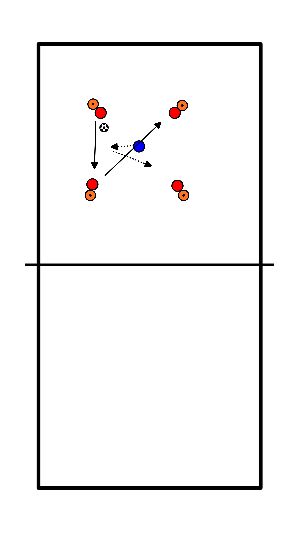Soccer drills
- Asking the ball and turning with a cross
- Third man comes in
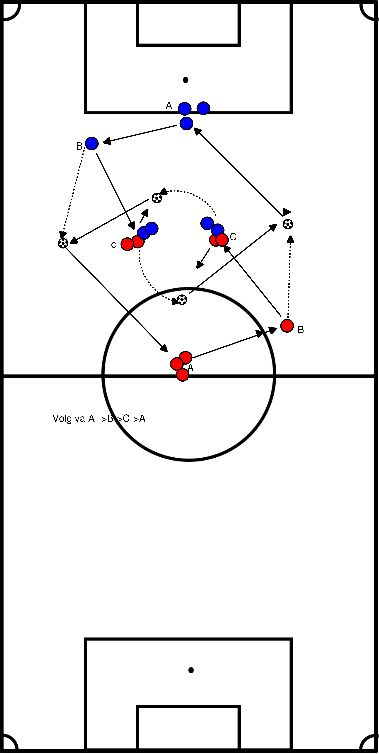
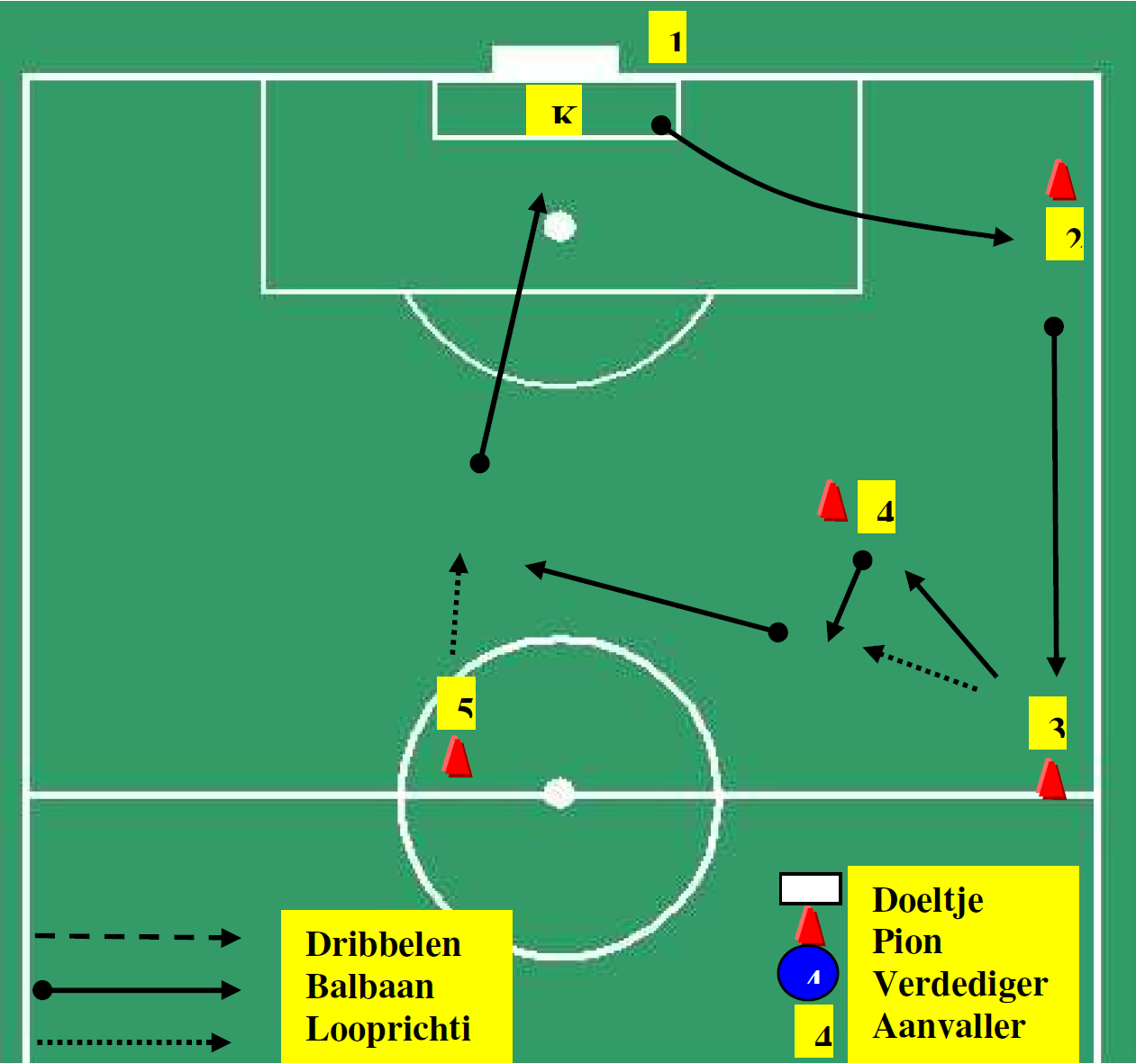
Content
- No. 1 or goalkeeper takes a goal kick
- No. 2 takes the ball
- No. 2 gives a depth pass on no. 3
- No. 3 plays in on no. 4 this comes in the ball
- No. 4 makes room for the incoming player
- No. 3 plays no. 5 to
- No. 5 takes the ball and scores
Structure of the exercise form
- At number 1 two players with a ball
- At 2, 3 and 5 three players
- Move from 1 to 5
- If there is no goalkeeper then 5 goes on goal
- Increasing/reducing distances
- Responding to the outer leg
- Eye contact and getting into the ball
- At position 4, add a defender
- Ball over the ground and/or through the air
- In case of delay, player 1 takes the goal kick
Coaching
- When No. 1 has control over the ball, only then come into the ball
- At no. 4 first away from the ball and then into the ball
- Ensuring that one does not fall short of each other that's easy to defend
Twos / two rows of hats / caps / ladders
- passing between two pylons. On the whistle, sprint around the ladder
- Carroussel: Ladders up, run back passing
- Think about it!: Jump down, jump down, jump left, right, left!
- Team spirit sitting side by side, arms crocheted, lying down and then doing sit ups
- One player runs via ladder and the other throws the ball into the hands
- One player runs through the ladder and the other throws the ball for a header
- Short steps over the ladder, then zigzag through the pylons, there sprint to the end where there is a pylon.
- Circle warming up: Circle around and sprint to the center.
- Fun warm up, form pairs of two and then walk around while you push against each other
- Throw over thigh control and volley
- Throw over chest control and volley
- ZigZag around your own pilons forward backward
- High stairs
- ball tapping, head ball back
- knee tapping (whistle)
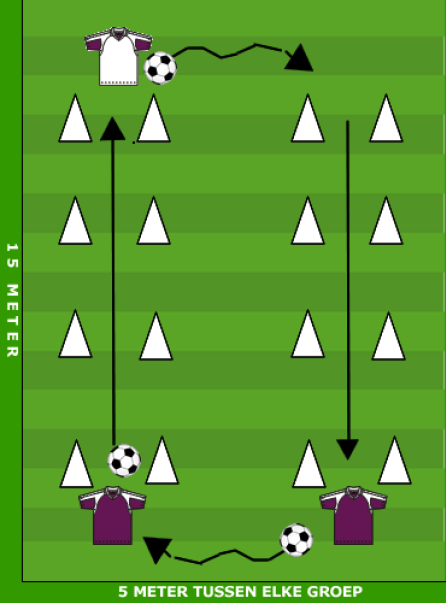
Field setup:
- Place 2 x 4 x 2 pilons next to each other so that two streets of pilons are formed.
The course of play:
- The players have to try to pass exactly through the pilon street and then sprint through it after the ball.
- Another player (white) receives the ball and dribbles to the other street.
- There this player does exactly the same towards player 3.
- Player 3 starts again on the same spot as player 1.
Laws of the Game:
- The ball must pass through the pilon street.
- If you hit a pilon, you have to sprint to straighten the pilon and try again.
- The ball must pass all pilons before the receiving player can take it.
- Pairs of two
- One of them rolls the ball and the other passes back.
- the passer runs back and forth between a pilon and the place of passing
- Challenge is to play as much passes as possible in 45 seconds.
- Two groups of players
- 1 defender
- The defender attacks and the attacker must try to score
- After a shot at goal, the attacker takes over the defender's place and an attacker from the other group tries to score.
- Again tha attacker shoots and takes the place of the defender.
- And so on.
- Try to keep up the pace.
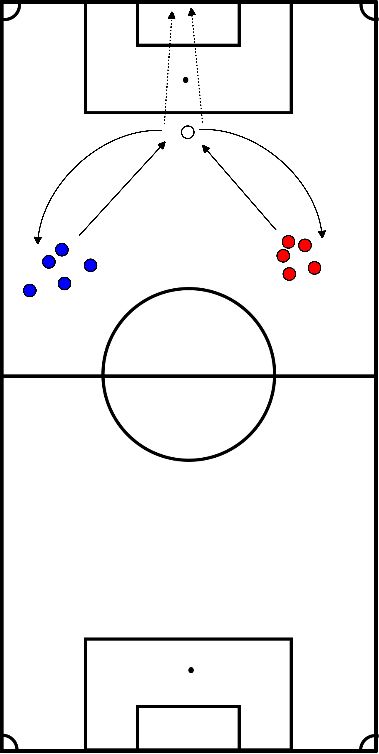
- Put out a square.
- Each corner has a colour (hat, jacket, ...).
- When jogging randomly across the field, call out colour and then sprint to the corner.
- Make sure you respond quickly and cleanly
- Also pay attention to the ball and running line

- Defenders at first and second posts, defenders in front of the goal and catch the attackers.
- Attackers move forward as soon as the ball is played high.
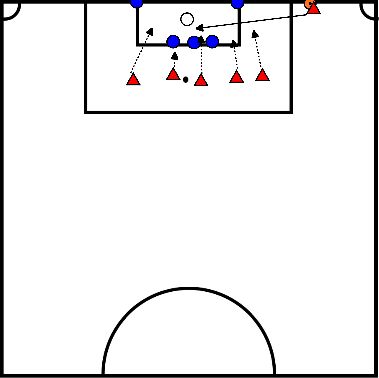
- The following exercise contains a lot of speed, agility, coordination, passing and even duelling.
- A speed exercise that can be done at any time of the training.
- Any age group can do this exercise. There are enough variations possible that you can apply yourself.
- With the younger and even the older groups the FUN aspect is also very pleasant.
- You can apply this form of exercise to different distances. It is especially important to look at your age group and what you want to achieve.
- Both players A leave with shoulder to shoulder until they're between the poles.
- (1), They then accelerate around the pilon and go back to the stick
- (2,3). Behind the stick, they go sideways over the hurdles
- (4). Again they go behind the stick and accelerate forward to the stick that's the furthest away.
- (5). Back to the other pole again
- (6) to then get a ball played in from B
- (7) on which A finishes on target
- (8).Player who finishes first wins.
- In the older ages you can have the loser do push-ups or do an extra job.
- At younger ages you add up the points.
- A takes the place of B and B goes to A.
- As a variation, you can have players B throw up the ball so that A has to head the ball inside the goal.
- As you can see, it is all about speed, agility and coordination
- Whoever wins, it's always fun and hard work is done
- Have fun with this speed exercise and let us know what you thought of it
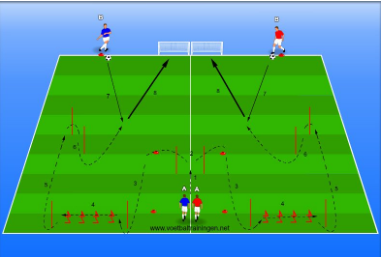
- Scoring by dribbling across the goal line
- Playing out of the situation through good positional play
- Ball control in the positional play
- Act fast, be able to pass directly
- Keep an overview of the situations for moving the game and choosing the moment and direction of the passing action
- Cutting off the opponent's pass and keeping them off the ball
- Coaching defenders to cut the line off the pass
- Defenders coach on giving coverage (standing diagonally behind each other)
- 5 players in a square of 8 x 8 meters.
- On each corner 1 player and in the middle a player.
- The ball is passed around.
- The players who play the ball around may only touch the ball twice.
- The player in the middle has to touch or conquer the ball.
- If he/she already has or has touched the ball, this player takes over the position of the player at the corner that touched the ball last.
- The player playing the ball outside must also take the place of the player in the middle.
